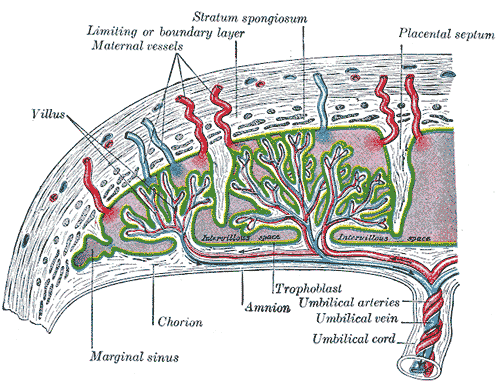Decidua
|
WikiDoc Resources for Decidua |
|
Articles |
|---|
|
Most recent articles on Decidua |
|
Media |
|
Evidence Based Medicine |
|
Clinical Trials |
|
Ongoing Trials on Decidua at Clinical Trials.gov Clinical Trials on Decidua at Google
|
|
Guidelines / Policies / Govt |
|
US National Guidelines Clearinghouse on Decidua
|
|
Books |
|
News |
|
Commentary |
|
Definitions |
|
Patient Resources / Community |
|
Directions to Hospitals Treating Decidua Risk calculators and risk factors for Decidua
|
|
Healthcare Provider Resources |
|
Causes & Risk Factors for Decidua |
|
Continuing Medical Education (CME) |
|
International |
|
|
|
Business |
|
Experimental / Informatics |
Editor-In-Chief: C. Michael Gibson, M.S., M.D. [1]
Overview
Decidua is the term for the uterine lining (endometrium) during a pregnancy, which forms the maternal part of the placenta. It is formed under the influence of progesterone and forms highly-characteristic cells.
Etymology
The word comes from the Latin deciduus, meaning falling off or shedding.
Background
After ovulation, in mammals, the endometrial lining becomes transformed into a secretory lining in preparation of accepting the embryo. Without implantation, the secretory lining will be absorbed (estrous cycle) or shed (menstrual cycle).
With implantation the lining now termed decidua evolves further during the pregnancy.
The decidua is shed during the parturition process.
Structure
Different layers of the deciduas have been described:
- a compact outer layer (stratum compactum)
- an intermediate layer (stratum spongiosum)
- a boundary layer adjacent to the myometrium.
That part of the decidua that interacts with the trophoblast is the decidua vera (“true decidua”). The remainder of the decidua is termed the decidua parietalis.
The decidua has a histologically-distinct appearance, displaying large polygonal decidual cells in the stroma. These are enlarged endometrial stromal cells, which resemble epithelium (and are referred to as "epithelioid").
Formation of a specialized decidua is called decidualization, which is a special property of endometrium seen only in hemochorial placentation.
Decidualization includes the process of differentiation of the spindle-shape stromal fibroblasts into the plump secretory decidual cells, which create a pericellular extracellular matrix rich in fibronectin and laminin (similar to epithelial cells).
Vascularity, as well as vascular permeability, is enhanced in the decidualizing endometrium.
Its leukocyte population is distinct, with the presence of large endometrial granular leukocytes being predominant, while polynuclear leukocytes and B-cells are scant.
The large granular lymphocytes (CD56 bright) are called "uterine NK cells" or "uNK cells" in mice, and "decidual NK cells" or "dNK cells" in humans.
The border to the trophoblast is called Nitabuch’s layer.
Role
As the maternal interface to the embryo the decidua participates in the exchanges of nutrition, gas, and waste with the gestation. It also protects the pregnancy from the maternal immune system. Further, the decidua has to allow a very controlled invasion of the trophoblast.
In invasive placental disorders like placenta accreta decidualization have been consistently found to be deficient.
Hormone production
The decidua secretes hormones, growth factors, and cytokines. It has receptors for estrogen, progesterone, growth hormone, and others.
Among its products are hormones commonly associated with other organs such as cortisol, CRF, GnRH, prolactin, and relaxin. Decidual prolactin is not under dopaminergic control.
Pregnancy protein 14 (PP-14), also called placental protein 12, and Insulin-like growth factor-binding protein 1(IGFBP1) appear to be specific products of the secretory and decidual lining.
Other factors released include interleukin-15 and vascular endothelial growth factor (VEGF). A reasonable understanding of the role and interplay of these hormones and factors has not been evolved.
Other
- In case of an extrauterine pregnancy, the endometrium nevertheless becomes decidualized. A woman may shed the lining in the form of a decidual cast, which may be mistaken as a miscarriage, when, in fact, the ectopic still persists.
- A decidual reaction can be observed in tissue of the peritoneum and ovary during a pregnancy, and represents a response of stromal tissue to progesterone.
Additional images
-
Scheme of placental circulation.
